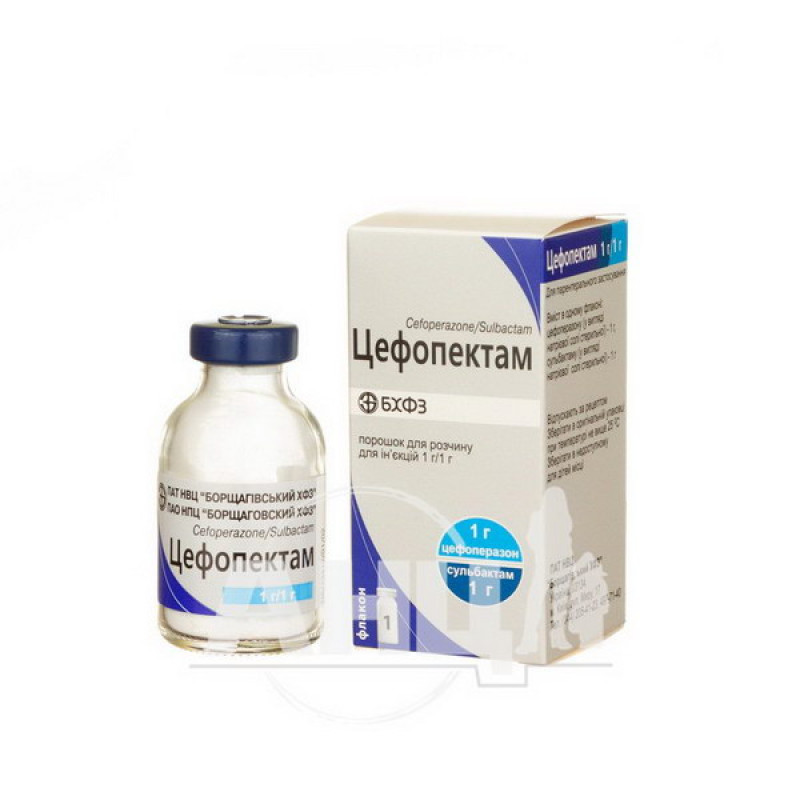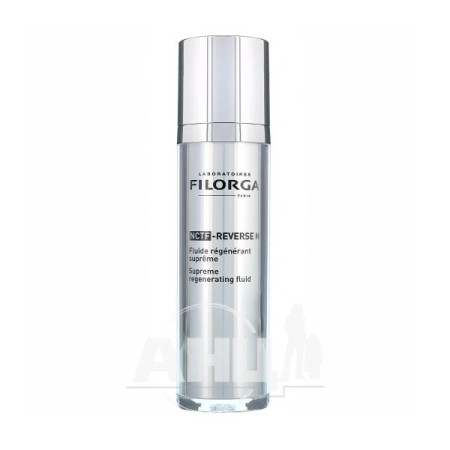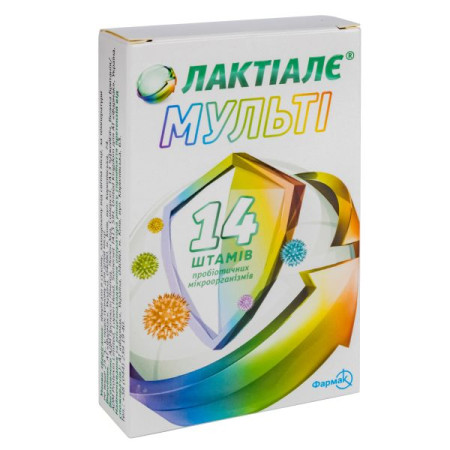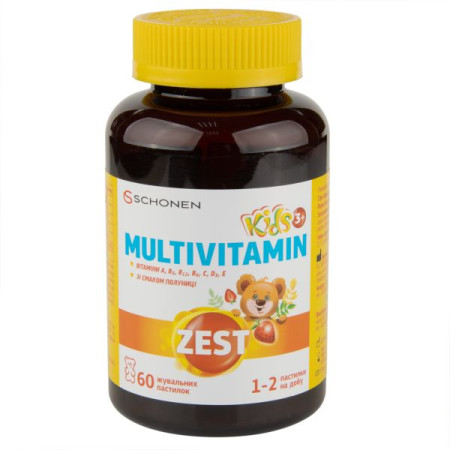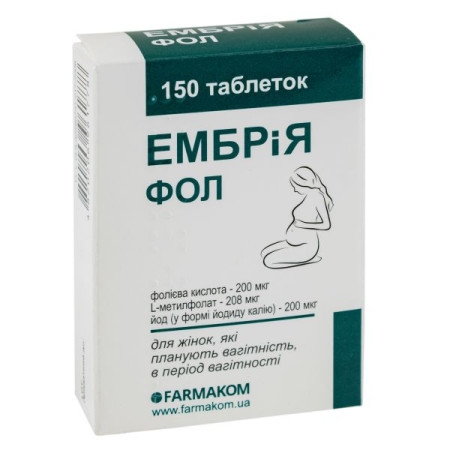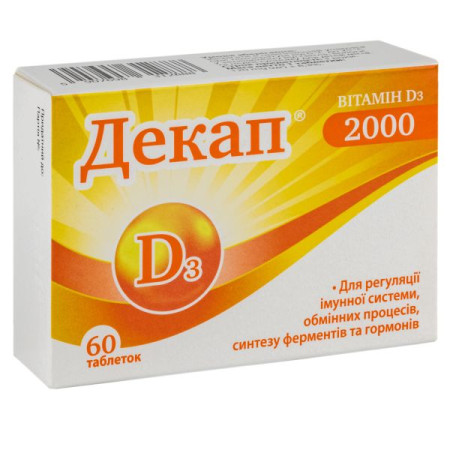Cefopectam powder for solution for injection 1 g + 1 g vial No. 1
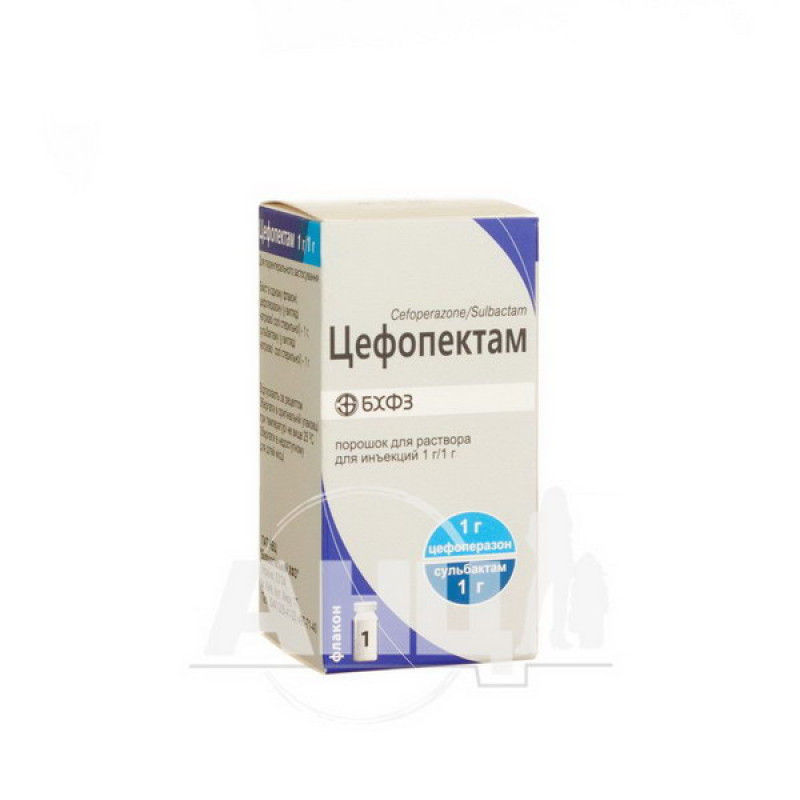
Cefopectam powder for solution for injection is indicated for infectious and inflammatory diseases caused by microorganisms sensitive to the drug:
respiratory tract infections (upper and lower); urinary tract infections (upper and lower); peritonitis, cholecystitis, cholangitis and other abdominal infections; skin and soft tissue infections; bone and joint infections; meningitis; septicemia; pelvic inflammatory disease, endometritis, gonorrhea and other genital infections.Composition
Active ingredients: cefoperazone, sulbactam;
1 vial contains cefoperazone (as sterile sodium salt) - 500 mg or 1 g and sulbactam (as sterile sodium salt) - 500 mg or 1 g, respectively.
Contraindication
Hypersensitivity to cephalosporin antibiotics, penicillins, sulbactam, cefoperazone and other beta-lactam antibiotics.
Method of application
Adults. The usual dose of Cefopectam for adults is 2-4 g per day (i.e. 1-2 g per day of cefoperazone) intravenously or intramuscularly, in equally divided doses every 12 hours.
Children. The usual dose of Cefopectam for children is 40-80 mg/kg/day (20-40 mg/kg/day of cefoperazone), divided into 2-4 doses.
Neonates. Neonates of the 1st week of life should be given the drug every 12 hours. The maximum daily dose of sulbactam for children should not exceed 80 mg/kg body weight (160 mg/kg/day of Cefopectam). If a dose of cefoperazone exceeding 80 mg/kg/day is required, an additional dose of cefoperazone should be administered separately.
Application features
Pregnant women
Use during pregnancy is possible only in exceptional cases for vital indications.
Children
It is used for children from the first days of life.
Drivers
Clinical experience with the use of cefoperazone/sulbactam suggests that the effect of the drug on the reaction rate when driving or using other mechanisms is unlikely.
Overdose
Information on the acute toxicity of cefoperazone sodium and sulbactam sodium in humans is limited.
Symptoms: the expected manifestations of overdose are, first of all, an increase in the manifestations of side effects. It should be borne in mind that high concentrations of beta-lactam antibiotics in the cerebrospinal fluid can cause neurological reactions, in particular convulsions. Renal disorders and prolongation of prothrombin time are also possible.
Treatment: symptomatic. It is necessary to maintain the vital functions of the body and water-electrolyte balance, monitor prothrombin time and, if necessary, prescribe vitamin K. In case of convulsions - sedative therapy. Hemodialysis is possible to enhance the elimination of the drug, especially in patients with impaired renal function.
Side effects
The sulbactam/cefoperazone combination is generally well tolerated. Most adverse reactions are mild to moderate in severity.
Blood and lymphatic system: eosinophilia, hypoprothrombinemia, neutropenia (associated with prolonged use, reversible), thrombocytopenia, leukopenia, decreased hemoglobin and/or hematocrit, anemia, bleeding, vitamin K deficiency, prolonged prothrombin time. Immune system: (these reactions are more common in patients with allergies, especially to penicillin): hypersensitivity reactions, anaphylactic reactions (including laryngospasm, bronchospasm, dyspnea, anaphylactic shock), anaphylactoid reactions (including shock). Skin and subcutaneous tissue: maculopapular rashes, itching, urticaria, toxic epidermal necrolysis, Stevens-Johnson syndrome, exfoliative dermatitis. Nervous system: oral mucosal hyperesthesia, restlessness, headache, dizziness. Cardiovascular system: vasculitis, hemorrhage (including fatal outcome), hypotension, flushing, bradycardia/tachycardia, cardiogenic shock, cardiac arrest. Digestive tract: diarrhea, nausea, vomiting, pseudomembranous enterocolitis. Hepatobiliary system: transient increase in AST, ALT, alkaline phosphatase, bilirubin in blood plasma, jaundice. Human anatomical models: hematuria. General manifestations and disorders associated with the method of administration of the drug: fever, chills, fasciculations, increased sweating, phlebitis at the catheter site, pain at the injection site. Laboratory indicators: increased blood urea nitrogen, increased serum creatinine (temporarily), cylindruria, positive direct Coombs test. Effects due to the biological action of the drug: possible development of superinfection (including candidomycosis, genital mycosis) caused by resistant microorganisms.Interaction
Alcohol (ethanol): Disulfiram-like reactions (hot flushes, sweating, headache, and tachycardia) have been reported with alcohol consumption during and for 5 days after treatment with cefoperazone. Patients should avoid alcohol and alcohol-containing medications during and for 5 days after treatment with cefoperazone. Solutions containing ethanol should not be used during artificial nutrition (oral or parenteral).
Nonsteroidal anti-inflammatory drugs, antiplatelet agents, vitamin K antagonists (warfarin): increased risk of bleeding.
Storage conditions
In the original packaging at a temperature not exceeding 25 °C.
Keep out of reach of children.
Shelf life - 2 years.
There are no reviews for this product.
There are no reviews for this product, be the first to leave your review.
No questions about this product, be the first and ask your question.






